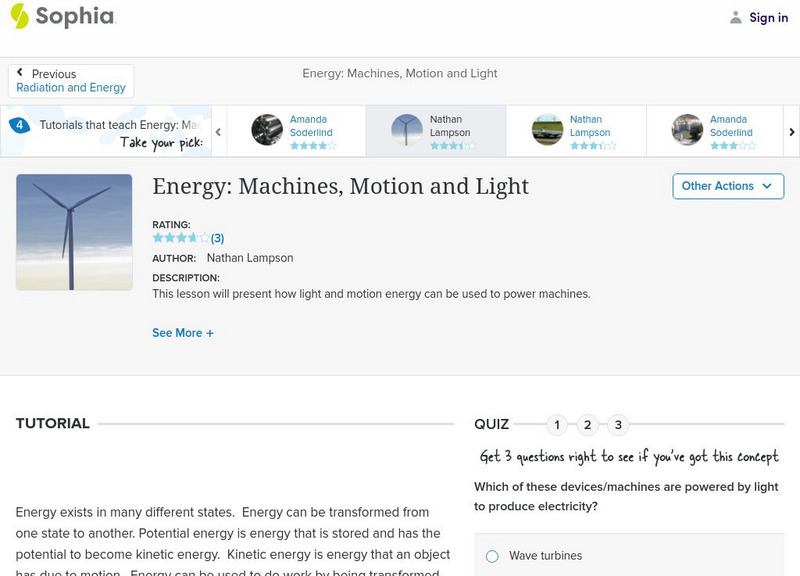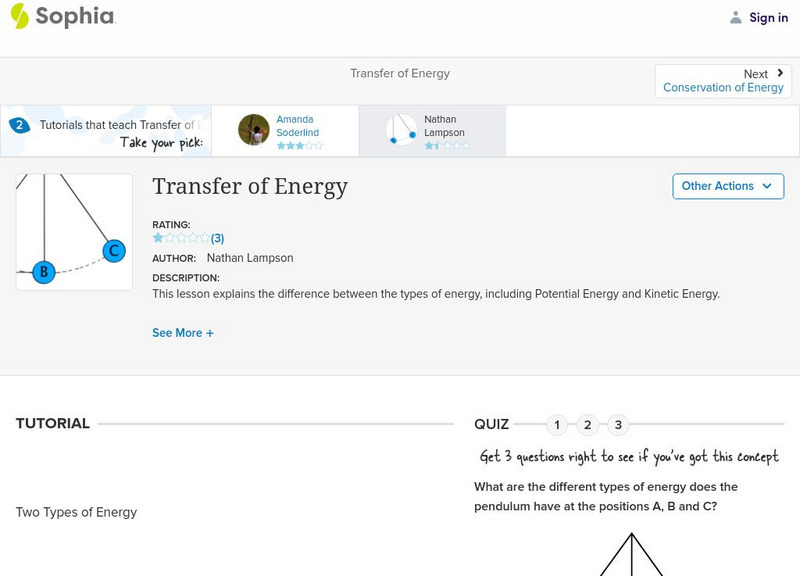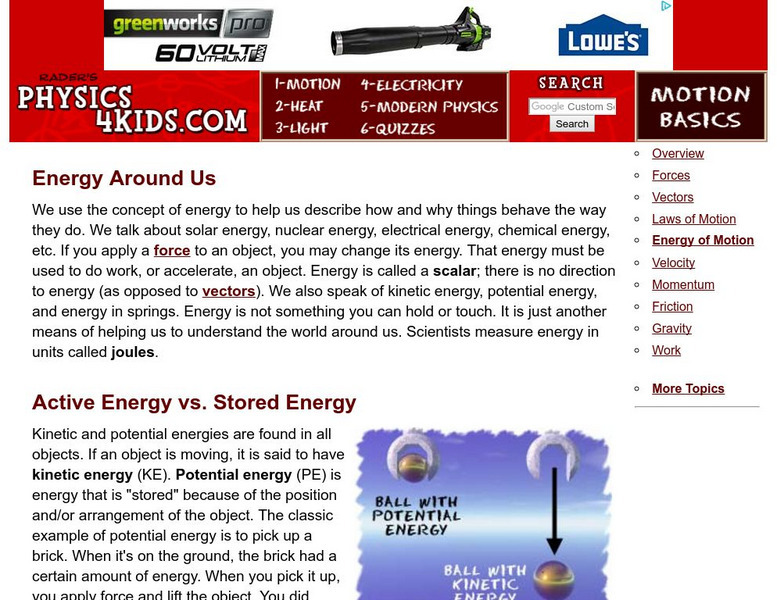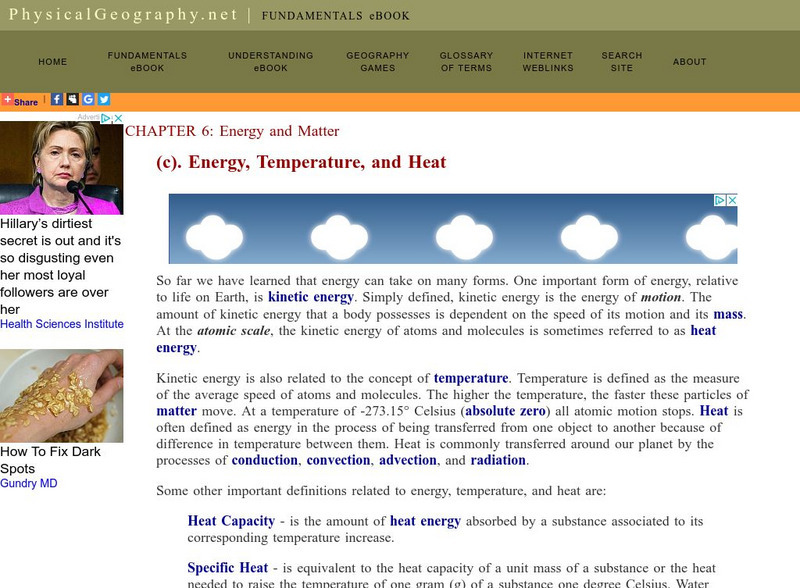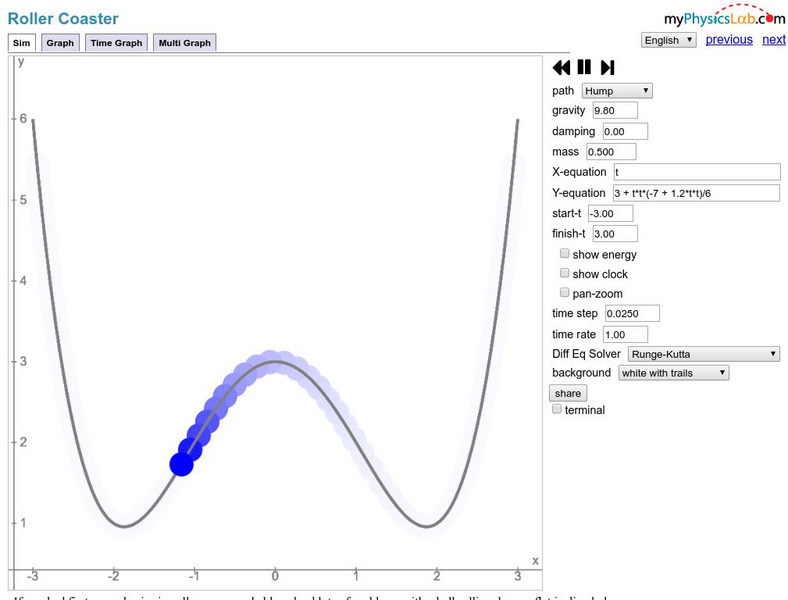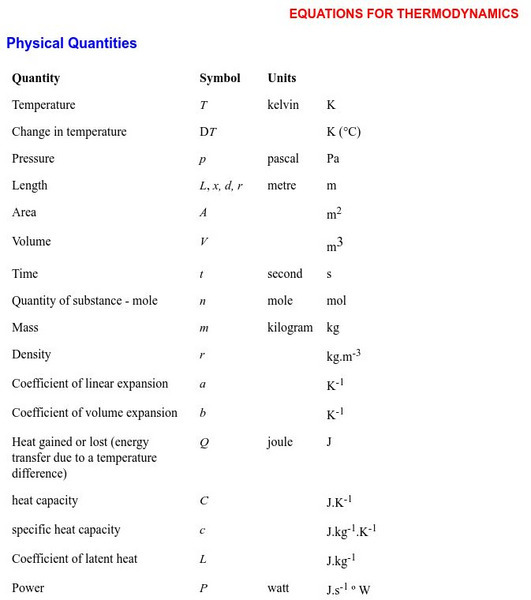Hi, what do you want to do?
Physics4kids
Physics 4 Kids: Energy in Motion Quiz
Take this ten question multiple choice quiz on energy in motion.
Sophia Learning
Sophia: Energy: Machines, Motion and Light: Lesson 2
This lesson will present how light and motion energy can be used to power machines. It is 2 of 4 in the series titled "Energy: Machines, Motion and Light."
Sophia Learning
Sophia: Kinetic Energy & Work
This lesson explains how kinetic energy and work are related.
Sophia Learning
Sophia: Transfer of Energy: Lesson 2
This lesson explains the difference between the types of energy, including Potential Energy and Kinetic Energy. It is 2 of 2 in the series titled "Transfer of Energy."
Ducksters
Ducksters: Physics for Kids: Kinetic Energy
Kids learn about kinetic energy in the science of physics. The energy of motion can be calculated using mass and velocity. The standard unit is the joule. How it is different from potential energy.
Ducksters
Ducksters: Physics for Kids: Potential Energy
Kids learn about potential energy in the science of physics. The energy of position and state can be calculated using mass, gravity, and height. The standard unit is the joule. How it is different from kinetic energy.
Other
Forms of Energy: Heat, Radiant, Electrical, Chemical, Nuclear Energy
Explains what each of these types of energy is and provides examples.
Other
Maths Revision: Work, Energy & Power
Basic definitions and examples for the concepts of work, energy, and power. Covers kinetic and potential energy, and conservation of energy.
Mocomi & Anibrain Digital Technologies
Mocomi: What Is Kinetic Energy?
Check out the slideshow defining and describing kinetic energy. What is the difference between potential and kinetic energy?
Physics4kids
Physics4 kids.com: Energy Around Us
If you need a brief overview of energy than check out this website. Energy is defined and several different types of energy are mentioned. The site also has an online quiz you can take to measure your understanding.
Other
Fund. Of Phys. Geography/energy, Temperature, and Heat
A page describing (in part) the distinction between energy, temperature and heat. Includes a graphic illustrating the quantity of energy needed to transform water between various states. Methods of thermal energy transfer (convection,...
Other
Characteristics of Energy and Matter
A lengthy page from the Fundamentals of Physical Geography site. Energy is distinguished from matter, and the different forms of energy are identified and discussed. Four types of heat transfer (convection, advection, conduction,...
Other
Laws of Thermodynamics
A page from the Fundamentals of Physical Geography site. Identifies, describes and elaborates upon the first, second, and third laws of thermodynamics.
Other
My Physics Lab: Roller Coaster
Create a simplified roller coaster with this simulation by creating a track shape for a ball to travel on. Students can change gravity and damping. Site includes equations to help students understand what is happening in the simulation.
TeachEngineering
Teach Engineering: Ready, Set, Escape
During this project, students will be asked to design a device that will measure out a time period of exactly 3 minutes. They will be asked to brainstorm ideas using the different materials provided. Students will observe and explain the...
Physics Classroom
The Physics Classroom: Energy Conservation on an Incline
This site is a discussion and animation about whether the total mechanical energy of a cart rolling down an incline is conserved, which can be determined if there are any external forces acting upon it.
Purdue University
General Chemistry Topic Review/heat
Heat is defined and explained; the concept of heat is related to the kinetic motion of particles and to temperature. Heat capacity and specific heat are explained. Sensible heat is compared to latent heat; reference is made to the heat...
PBS
Pbs Teachers: Spool Racer Experiment
Demonstrate stored and kinetic energy by making a racer toy from a spool and a rubber band.
Science Struck
Science Struck: Thermal Energy Facts
Explains what thermal energy is, describes some different types, and presents facts about each type.
Science Struck
Science Struck: Difference Between Kinetic and Potential Energy
Explains what kinetic and potential energy are and how they differ.
Science4Fun
Science4 Fun: Energy
What is energy? Article provides a brief discussion of the many different forms of energy.
SMART Technologies
Smart: Forms of Energy
Expose students to this introduction to several different forms of energy.
Museum of Science
The Atoms Family
Let this classic family of monsters guide you as you learn about energy. Interactive exercises, experiments, and demonstrations help to build knowledge and raise questions.
University of Sydney (Australia)
Equations for Thermodynamics
An exhaustive list of equations and formulas which are commonly used in thermal physics (including equations for triple point). Equations are organized according to category. Meaning of the symbols is clearly stated.






